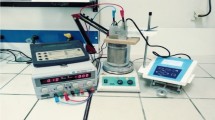Abstract
This study investigated the performance of electrocoagulation using iron and aluminum electrodes for removing silica, calcium and magnesium from cooling tower blowdown and reverse osmosis reject waters. Experiments were conducted at both the bench and pilot scales to determine the levels of target species removal as a function of the coagulant dose. At the bench scale, aluminum removed the target compounds from both cooling tower blowdown and reverse osmosis reject more efficiently than iron. A 2 mM aluminum dose removed 80 % of the silica and 20 to 40 % of the calcium and magnesium. The same iron dose removed only 60 % of the silica and 10 to 20 % of the calcium and magnesium. When operated with iron electrodes, pilot unit performance was comparable to that of the bench unit, which suggests that such systems can be scaled-up on the basis of coagulant dose. However, when operated with aluminum electrodes the pilot unit underperformed the bench unit due to fouling of the electrode surfaces after a few hours of operation. This result was completely unexpected based on the short-term experiments performed using the bench unit.
Similar content being viewed by others
References
Abdel-Ghani, N.T.; El-chaghaby, G. A., (2007). Influence of operating conditions on the removal of Cu, Zn, Cd and Pbions from wastewater by adsorption. Int. J. Environ. Sci. Tech., 4 (4), 451–456 (6 pages).
Adhoum, N.; Monser, L.; Bellakhal, N; Belgaied, J. E., (2004). Treatment of electroplating wastewater containing Cu2+, Zn2+ and Cr(IV) by electrocoagulation. J. Hazard. Mater., 112 (3), 207–213 (7 pages).
Akpor, O. B.; Momba, M. N. B.; Okonkwo, J. O.; Coetzee, M. A., (2008). Nutrient removal from activated sludge mixed liquor by wastewater protozoa in a laboratory scale batch reactor. Int. J. Environ. Sci. Tech., 5 (4), 463–470 (8 pages).
Bayat, O.; Kilic, O.; Bayat, B.; Anil, M.; Akarsu, H.; Poole, C., (2006). Electrokinetic dewatering of Turkish glass sand plant tailings. Water Res., 40 (1), 61–66 (6 pages).
Behera, S. K.; Rene, E. R.; Murthy, D. V. S., (2007). Performance of up - flow anoxic bioreactor for wastewater treatment. Int. J. Environ. Sci. Tech., 4 (2), 247–252 (6 pages).
Bektas, N.; Akbulut, H.; Inan, H.; Dimoglo, A., (2004). Removal of phosphate from aqueous solutions by electrocoagulation. J. Hazard. Mater., 106 (2-3), 101–105 (5 pages).
Can, O. T.; Kobya, M.; Demirbas, E.; Bayramoglu, M., (2006). Treatment of the textile wastewater by combined electrocoagulation. Chemosphere, 62 (2), 181–187 (7 pages).
Canizares, P.; Carmona, M.; Lobato, J.; Martinez, F.; Rodrigo, M. A., (2005). Electrodissolution of aluminum electrodes in electrocoagulation processes. Ind. Eng. Chem. Res., 44 (12), 4178–4185 (8 pages).
Chen, G., (2004). Electrochemical technologies in wastewater treatment. Sep. Purif. Tech., 38 (1), 11–41 (31 pages).
Den, W.; Huang, C., (2006). Parameter optimization and design aspect for electrocoagulation of silica nano-particles in wafer polishing wastewater. Water Sci. Tech., 53 (6), 187–194 (8 pages).
Den, W.; Huang, C., (2008). Removal of silica from brackish water by electrocoagulation pretreatment to prevent fouling of reverse osmosis membranes. Sep. Purif. Tech., 59 (3), 318–325 (8 pages).
Gao, P.; Chen, X.; Shen, F.; Chen, G., (2005). Removal of chromium (VI) from wastewater by combined electrocoagulation-electroflotation without a filter. Sep. Purif. Tech., 43 (2), 117–23 (7 pages).
Gu, Z.; Liao, L.; Schulz, M.; Davis, J. R.; Baygents, J. C.; Farrell, J., (2009). Estimating dosing rates and energy consumption for electrocoagulation using iron and aluminum electrodes. Ind. Eng. Chem. Res., 48 (6), 3112–3117 (6 pages).
Holt, P. K.; Barton, G. W.; Mitchell, C. A., (2005). The future for electrocoagulation as a localized water treatment technology. Chemosphere, 59 (3), 355–367 (13 pages).
Kannan, N.; Karthikeyan, G.; Tamilselvan, N., (2006). Comparison of treatment potential of electrocoagulation of distillery effluent with and without activated Areca catechu nut carbon. J. Hazard. Mater., 137 (3), 1803–1809 (7 pages).
Kumar, P. R.; Chaudhari, S.; Khilar, K. C.; Mahajan, S. P., (2004). Removal of arsenic from water by electrocoagulation. Chemosphere, 55 (9), 1245–1252 (8 pages).
Laridi, R.; Drogul, P.; Benmoussa, H.; Blais, J. F.; Auclair, J. C., (2005). Removal of refractory organic compounds in liquid swine manure obtained from a biofiltration process using an electrochemical treatment. J. Environ. Eng., 131 (9), 1302–1310 (9 pages).
Lin, C. J.; Lo, S. L.; Kuo, C. Y.; Wu, C. H., (2005). Pilot-scale electrocoagulation with bipolar aluminum electrodes for on-site domestic greywater reuse. J. Environ. Eng., 131 (3), 491–495 (5 pages).
Mickley, M., (2004). Pretreatment capabilities and benefits of electrocoagulation. United States Office of Naval Research, Washington, DC, USA.
Mollah, M. Y. A.; Morkovsky, P.; Gomes, J. A. G.; Kesmez, M.; Parga, J.; Cocke, D. L., (2004). Fundamentals, present and future perspectives of electrocoagulation. J. Hazard. Mater., 114 (1-3), 199–210 (12 pages).
Picard, T.; Cathalifaud-Feuillade, G.; Mazet, M.; Vandensteendam, C., (2000). Cathodic dissolution in the electrocoagulation process using aluminium electrodes. J. Environ. Monit., 2 (1), 77–80 (4 pages).
Schulz, M. C., (2008). Electrocoagulation applied to water conservation and waste treatment., M.Sc. Thesis, University of Arizona.
Soltanali, S.; Shams Hagani, Z., (2008). Modeling of air stripping from volatile organic compounds in biological treatment processes. Int. J. Environ. Sci. Tech., 5 (3), 353–360 (8 pages).
Zhu, B.; Clifford, D. A.; Chellam, S., (2005). Comparison of electrocoagulation and chemical coagulation pretreatment for enhanced virus removal using microfiltration membranes., Water Res., 39 (13), 3098–3108 (11 pages).
Author information
Authors and Affiliations
Corresponding author
Rights and permissions
About this article
Cite this article
Schulz, M.C., Baygents, J.C. & Farrell, J. Laboratory and pilot testing of electrocoagulation for removing scale-forming species from industrial process waters. Int. J. Environ. Sci. Technol. 6, 521–526 (2009). https://doi.org/10.1007/BF03326091
Received:
Revised:
Accepted:
Published:
Issue Date:
DOI: https://doi.org/10.1007/BF03326091




